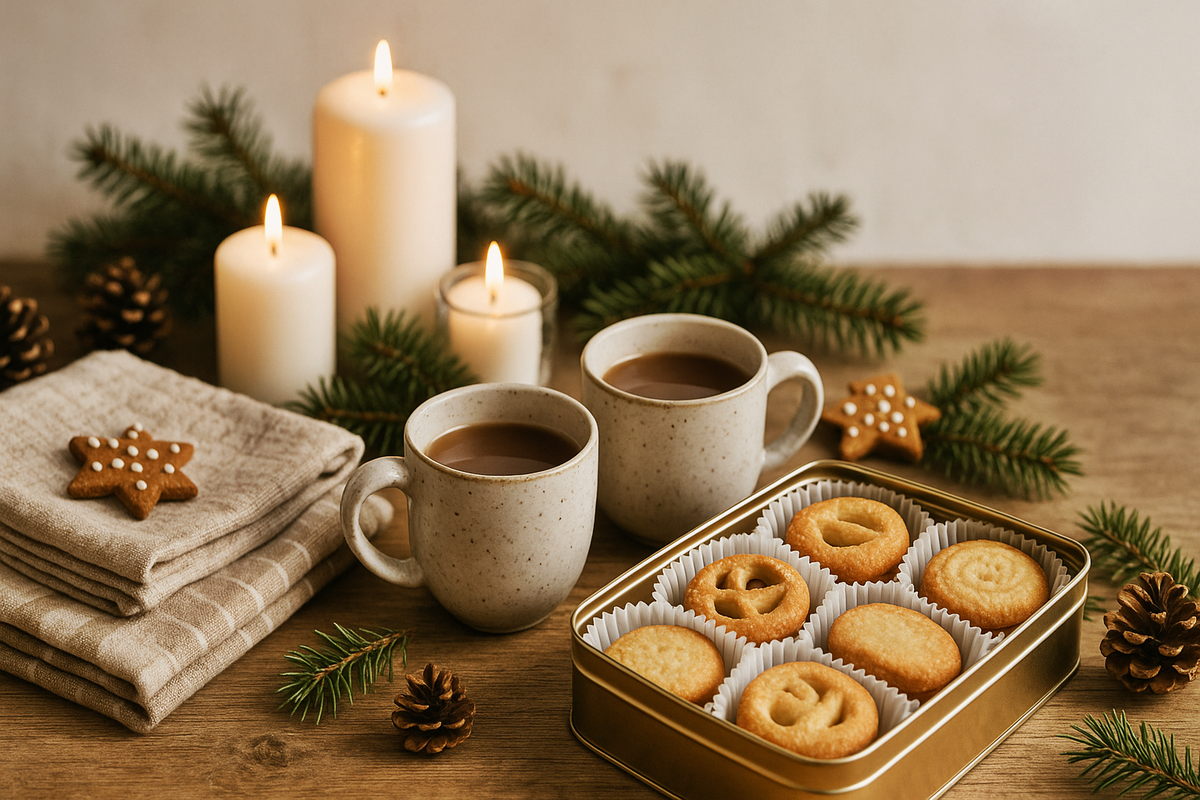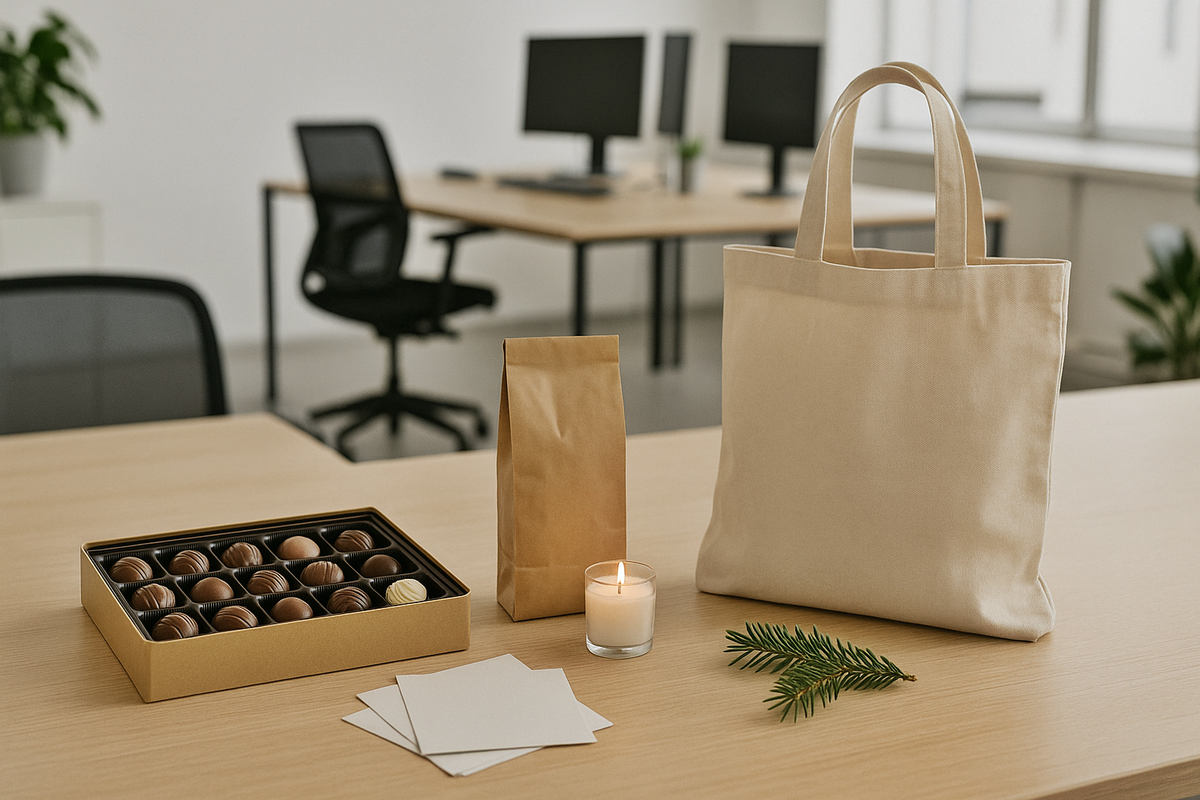🎁 Danish-style gifts: what to give your family and colleagues without being overly pretentious
Danish gift-giving culture is built around the idea of moderation: thoughtfulness and usefulness are more important than price tags and wow factors. Here, people value things that will actually be used: candles, textiles, ceramics, delicious food and drinks, rather than ostentatious luxury. 🎂
The same principle applies in a business context: no ‘obligatory’ expensive gifts, minimal pretentiousness, maximum respect for personal boundaries. For colleagues and partners, small, neutral and understandable gifts are sufficient — most often edible ones. 🍫
Key guideline: if a gift looks too expensive or personal, a Dane may feel uncomfortable — instead of gratitude, you will get the feeling that ‘they are pressuring me to reciprocate’.
This article is aimed at those who are travelling to Denmark to visit friends, live/work here as an expat, or are planning a Christmas trip and want to ‘fit in’ in terms of style and budget. ✨
🏠 Gifts for the home: hygge without overload

🕯️ Candles and scents
Candles are an almost foolproof choice for a Danish home. These can be:
- classic long candles for candlesticks;
- thick ‘pillars’ for trays and coasters;
- small scented candles with neutral scents (pine, spicy, ‘clean house’).
The main thing is to avoid overly strong scents and flashy designs. Minimalism, calm colours, high-quality wax — that's what you'd expect to find on a Danish table.
🧵 Textiles and cosy little things
Textiles are another basic gift in the Danish style: a set of kitchen towels; linen or cotton napkins; a tablecloth in a calm colour scheme; a pillowcase or a small blanket. 🛋️
These are items that are easy to incorporate into any interior and that are actually used every day. The guideline is natural materials, neutral colours, and no huge logos.
☕ Ceramics and tableware
In Denmark, people love beautiful but functional tableware. Good gifts include a mug or pair of mugs for coffee/tea; cups for gløgg; small dishes, bowls, and sauce boats.
It is not necessary to buy expensive premium brands: neat local ceramics or simple Scandinavian designs from mass-market stores will be just as well received. The main thing is that the item is suitable for everyday use.
🍬 Food, sweets and gløgg sets
Edible gifts are a universal and safe option: high-quality chocolate or sweets; Danish biscuits, gingerbread, marzipan; good coffee or tea; a gløgg set (spices + base drink/syrup).
Such a gift ‘covers’ both the moment of shared consumption at the table and the tradition of Christmas treats.
📊 Approximate price ranges
Below are budget guidelines per recipient (in DKK) to give you an idea of the order of magnitude, rather than exact amounts:
| Category | Budget (~up to 100 DKK) | Mid-range (~100–250 DKK) | Above average (250+ DKK) |
|---|---|---|---|
| Candles | 2–4 simple candles or a small set | Small set + candle holder | Designer candle holder + candles |
| Textiles | 1–2 kitchen towels | Towel set or tablecloth | Blanket / set of cushion covers |
| Ceramics/tableware | One mug | A pair of mugs or a small set of bowls | Branded ceramics or serving set |
| Sweets/food | Biscuits/chocolate | Sweets selection + coffee/tea | Large gift basket |
| Gløgg set | Spices in a sachet | Spices + base drink | Extended “gløgg evening” set |
Important: in the Danish context, the ‘average level’ is most often considered optimal; anything that goes far beyond premium is justified only for very close people.
💼 Gifts for colleagues and partners: no fuss and no personal boundaries

☕ What is appropriate to give to colleagues
The logic is simple: a small, neutral, ‘easily divisible’ gift. Suitable gifts include:
- chocolate, biscuits, a box of sweets ‘for everyone’ in the office;
- a packet of good coffee or tea;
- a small candle, mini candlestick;
- inexpensive shopping bag, notebook, pen.
Such things do not look like an attempt to stand out or ‘suck up’, but create a pleasant background and do not require a return gift.
🎟️ Gifts from the company to employees
Often, Christmas gifts come from the employer:
- a gift basket with food and drinks;
- a gift certificate to a store;
- a group dinner/event instead of a physical gift.
Companies are guided by tax limits on gifts, so the cheque is usually reasonable and moderate, without ostentatious luxury.
❌ What to avoid in the office
Gift formats that are inappropriate in Danish work culture:
- too personal (perfume, clothing, jewellery);
- too expensive (watches, technology, obvious luxury brands);
- ‘obligatory’ gifts (something that a person cannot avoid using/showing).
A safe price range for a personal gift to a colleague is a small item in the ‘budget/medium’ range, where the main thing is the thought, not the amount.
🛍️ Where to shop ‘Danish style’ rather than ‘tourist style’

🥐 Supermarkets and bakeries
For edible gifts, you don't have to go to specialised souvenir shops:
- large supermarkets offer Christmas sets of sweets, coffee, biscuits, and chocolate;
- bakeries offer fresh pastries, Christmas cakes, kringle, and bread in beautiful bags;
- and you can often find ready-made mini sets for gløgg.
This is a case where you buy the same things that the Danes themselves buy for their tables.
🏷️ Mass chains with decorations and trinkets
Inexpensive Scandinavian chains are a good source of small gifts and packaging:
- decorations, candlesticks, candles;
- kitchen textiles, tableware, boxes and jars;
- wrapping paper, ribbons, cards.
Prices in such shops are usually significantly lower than in souvenir shops in purely tourist areas, and the range is ‘homely’ Danish.
🎨 Design shops and how not to go overboard
If you want to add a more ‘designer’ touch, you can visit large Scandinavian design shops. There, it makes sense to:
- choose one small but high-quality item (a mug, candlestick, towel);
- don't fill your basket with them — otherwise, the bill will quickly reach thousands of DKK.
The best strategy is to buy the basics (sweets, some textiles, packaging) in supermarkets and chain stores, and one ‘signature’ item in a design shop.
🎁 Packaging and etiquette: how to give gifts ‘the Danish way’

📮 Packaging: simple, neat, without drama
The Danish style of packaging is:
- craft or plain paper (red, white, green, dark blue);
- a single ribbon or twine, sometimes a sprig, fir greenery, or a small ornament;
- a small, concise card.
The main thing is neatness and the absence of the feeling of a ‘gift for Instagram.’ Minimalism looks natural and appropriate here.
🌍 Etiquette: when and how to give
Basic rules:
- when visiting, it is customary to bring something small: sweets, wine, flowers or a gift for the home;
- gifts are usually opened immediately, in front of the giver, and not put off ‘until later’;
- The text on the card can be very concise: ‘Thank you for the invitation’ / ‘Wishing you a peaceful hyggelig Christmas.’
In multinational offices, packaging and cards are often made neutral, without any pronounced religious symbols — this is good form and shows respect for diversity.
✅ Quick checklist of ideas and budgets by category

To simplify preparation, you can start with three scenarios: family/friends, colleagues/office, and ‘special occasions.’
🔍 Summary table of ideas
| For whom | Gift ideas | Budget per person* |
|---|---|---|
| Family and close ones | Candles, blanket, textiles, ceramics, sweets, gløgg set, book, board game | ~150–400 DKK |
| Friends | Candle, mug, sweets, coffee/tea, small décor item | ~100–250 DKK |
| Colleagues (individually) | Chocolate, coffee, candle, notebook, tote bag | ~50–150 DKK |
| Team/office | Large box of sweets, coffee, fruit, shared gift basket | Overall budget by agreement |
| “Special occasion” | Blanket, design object, home fragrance set, gift card | ~300–600 DKK (without excessive luxury) |
*The figures are guidelines in terms of order of magnitude, not strict limits.
📝 Mini checklist before buying
Before going to the shop, ask yourself a few questions:
- Who am I buying for? Family, close friend, colleague, boss, the whole team.
- How does he/she live? Small flat, house, children, pets, do they like to cook?
- How close are we? Can you afford a slightly more personal gift, or is it better to stick to something neutral?
- What format is appropriate? Edible, for the home, symbolic, general office.
- Budget? Determine the range in advance and don't try to ‘catch up with the impression’ with the amount.
🎄The final principle of Danish gift-giving is simple: it is better to give a modest, useful and ‘lively’ gift that is in keeping with the style and budget than an expensive and complicated gesture that makes everyone feel uncomfortable. It is precisely such decisions that will be perceived in the ‘Danish way’ — without unnecessary pomp, but with respect and warmth.
❓FAQ
💬 Small, practical and cosy items for the home — candles, textiles, ceramics, sweets or a gløgg set — fit perfectly into Danish gift-giving culture.
💬 Most often, a range of approximately 100 to 300 DKK is appropriate for a personal gift, where care and quality are evident, but there is no sense of luxury for luxury's sake.
💬 Colleagues are usually given small, neutral gifts — chocolate, biscuits, coffee, a candle or a general ‘office treat’ — without expensive or personal gifts.
💬 It is more practical to combine supermarkets and bakeries for food and sweets with inexpensive chains such as decor and textile shops, and to buy one ‘accent’ item in a design shop if you wish.
💬 Neat, simple paper, a single ribbon or string, a small card and, if desired, a sprig of greenery are enough — without fancy elements and loud inscriptions.





0 comments
Log in to leave a comment